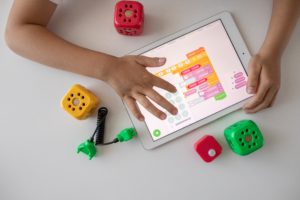We know that people are different and therefore, when it comes to learning, they have individual learning styles, needs and learn at a different pace. For instance, there are learners who can get hold of the meaning of a text in a book after reading it once, while others need to re-read the same text several times, perhaps even out-loud, or with making some notes as well, in order to understand its meaning. For some learners, simply seeing the words written on paper helps them make connections and understand the topic and idea behind it. That’s why they need to re-read a text to fully understand it. These are the so-called ‘visual learners’, who belong to around 65% of learners according to Prof. William C. Bradford (2011).
Visual learners can understand concepts easier when they are presented written either in text or using other visual support such as infographics, pictures, diagrams and videos. The visual aid offers them the ability to make connections and learn new things, develop skills, but also sustain the new information for a longer time.
Therefore, in educational settings, visual learning has gained traction as an effective learning approach and appealing way of learning for students of all ages and learning styles. By using visual and interactive model lessons, students can be more engaged but also understand and memorize the information better.
Especially, nowadays that youngsters use their mobile devices to learn things and look for information, they have been ‘trained’ to visual stimuli. Hence, providing learning material in various interactive forms that make use of images, videos and other graphics, is powerful and more interesting.

Photo by Robo Wunderkind on Unsplash
Nonetheless, there are many more benefits that visual and interactive model lessons can offer to help learners learn in their own learning style and pace. Below we list some of the most essential:
Increase learner’s motivation
As explained above, visual learning and interactive lesson models, drives learners’ attention and motivation by using appealing photos or images, engaging videos, and interesting, easy to understand infographics. This can help all learners (not only those keen to visual) to learn more effectively, and make learning fun, even if a subject is less interesting for some.
Stimulate learner’s emotions
Visual spurs emotional response by creating strong impressions which our brains can sustain for a long time as memories. In fact, using interactive visual material such as pictures and videos, can help for remembering things because these are linked to emotions that were generated once we received the visual information.
Improve comprehension
It is the purpose of using visuals and interactive modules to assist learners in grasping concepts easily by drawing their attention, stimulating imagination and affecting their cognitive capabilities.
Process information faster
Taking for example information presented in an infographic or using bullet points, it is obvious that the visual enables students to process the information much easier and quicker. Furthermore, the same information in the form of an image or a video is processed even more quickly as visuals are processed 60,000 times faster than text! Hence, it is effective to use suitable visuals to present or explain content to support learning.
Offers flexibility in teaching and learning
In the hands of the learners, interactive modules like videos offer great flexibility as learners can study at their own pace and pause the video tutorial for instance, to understand the concept or information more effectively. They can also rewind the video or zoom in an image and take time to analyse it before moving to the next step. On the other hand, from the teachers’ point of view, creating and using visual and interactive model lessons is a creative and fun process as well. It allows teachers to think of new ways to present the content/information and make teaching and learning creative and more engaging for them and their students!
Help in memorization and information anchoring
Learning to use good quality visuals and interactive lesson models can help learners store and memorize information for a long time. This is because our brain uses its long-term memory to process visual material (especially images), where they get permanently imprinted.
Supports learners with learning difficulties or disabilities
We have seen how many times, learners with learning difficulties can be visual learners and benefit from suitable visual and interactive learning material. Visual and interactive teaching and learning proves to be significant in this sense as it includes different forms of material like images, text, video, and audio for presenting the content of the lesson. This ensures that the learning needs of every learner are sufficiently met.
References:
Jandhyala, Dana. “Visual Learning: 6 Reasons Why Visuals Are The Most Powerful Aspect Of ELearning.” ELearning Industry, 8 Dec 2017, https://elearningindustry.com/visual-learning-6-reasons-visuals-powerful-aspect-elearning
Bradford, William C., Reaching the Visual Learner: Teaching Property Through Art (September 1, 2011). The Law Teacher Vol. 11, 2004, Available at SSRN: https://ssrn.com/abstract=587201

An Erasmus+ project
Visit the project’s website![]() Follow the project on Facebook : @Logopsycom
Follow the project on Facebook : @Logopsycom
#flashmind #erasmusplus
In collaboration with: Edulog, Les Apprimeurs, European Education & Learning Institute, Euphoria, Universitatea din Pitesti

